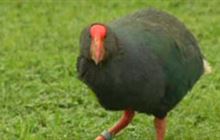Saddleback/tīeke
Introduction
The saddleback or tīeke belongs to New Zealand's unique wattlebird family, an ancient group which includes the endangered kōkako and the extinct huia.New Zealand status: Endemic
Conservation status: Recovering
Threats: Predation
Sound recordings:
North Island saddleback/tīeke song (MP3, 1,745K)
01:51 – Saddleback/tīeke song.
South Island saddleback/tīeke song (MP3, 1,406K)
01:29 – Two males giving territorial calls responding to playback of taped calls.
Species information: Saddleback on NZ Birds Online
Image gallery
Saddleback/tīeke conservation
There are two species: North Island saddleback (Philesturnus rufusater) and South Island saddleback (P. carunculatus). The more endangered of the two species is the South Island saddleback, with only around 650 birds in existence.
Saddlebacks were once widespread throughout New Zealand's mainland and island forests. Their decline began in the mid 19th century, caused by forest clearance and introduced predators such as ship rats, feral cats and stoats.
By this century, both species were close to extinction. South Island saddlebacks were limited to three islands: Big South Cape, Pukeweka, and Soloman Islands (near Stewart Island), while the North Island species was restricted to Hen Island in the Hauraki Gulf.
Rescued from disaster
In the early 1960s, disaster struck the southern species. A boat accidentally brought ship rats to Big South Cape Island (largest of its three island homes), and quickly spread to the other two. The result was an ecological nightmare for many endemic species and caused the extinction of the Stewart Island snipe, Stead's bush wren and the greater short-tailed bat.
The New Zealand Wildlife Service (now DOC) came to the rescue and saved the saddleback from extinction.
Early in 1964, the NZ Wildlife Service successfully transferred some North Island saddlebacks from Hen Island, Hauraki Gulf to nearby Whatapuke Island. This was possibly the first time the translocation of a species had been successfully carried out.
This led the way for the translocation of South Island saddlebacks from their rat-plagued islands to predator-free ones. The current population of over 700 birds is descended from the survivors of the 36 saddlebacks rescued in 1964.
This method of translocating species to island refuges continues to be a major strategy of DOC.
Island homes
The North Island saddleback is now resident on 19 islands and is in a favourable position to survive. The South Island species is on 11 smaller islands (500 ha) but its tiny founding population leaves it vulnerable to inbreeding.
Cooperation between local iwi, who harvest muttonbirds on several of the islands, and the department has been crucial to the success of the conservation work being carried out for the southern species.
Mainland sanctuaries
There are mainland North Island saddleback populations at five fenced sanctuaries, where they have been re-introduced from 'lifeboat' island populations: Zealandia Ecosanctuary, Bushy Park Sanctuary, Tawharanui Regional Park, Sanctuary Mountain Maungatautari and Rotokare Scenic Reserve.
Translocations are managed to maximise genetic diversity of all translocations, often with 2 or 3 source populations contributing to the establishment at new sites.
Recovery plan
South Island saddleback recovery plan (PDF, 207K)
The plan aims to:
- maintain wild saddleback populations, including protecting the 10 existing populations, eg Titi, Breaksea, Motuara and Allports islands
- adopt stringent rodent, weed and disease quarantine measures for the islands
- remove predators from islands suitable for saddlebacks and translocate the birds there
You can help
Emergency hotline
Call 0800 DOC HOT (0800 362 468) immediately if you see anyone catching, harming or killing native wildlife.
On your property
- Trap predators on your property.
- Be a responsible cat owner.
In your community
- Find and volunteer with your local community group
- Trap predators in your community
- Get kids or schools involved
See Predator Free 2050 Trust - get involved for information.
Visiting parks, beaches, rivers, and lakes
- Leave nesting birds alone.
- Use available access ways to get to the beach.
- Avoid leaving old fishing lines in the water.
- Follow the water care code and local navigation bylaws.
- Do not drive on riverbeds, or keep to formed tracks if you have to.
- Check for pests if visiting pest-free islands.
With your dog
- Only take dogs to areas that allow them, and keep them under control.
- If you come across wildlife put your dog on a lead and lead it away.
- Warn other dog owners at the location.
- Notify DOC if you see wildlife being harassed by people or dogs.
- Get your dog trained in avian awareness.
- Learn about the Lead the Way programme which encourages dog owners to become wildlife wise and know how to act to protect coastal wildlife.
Specific ways to keep wildlife safe while with your dog on beaches.


